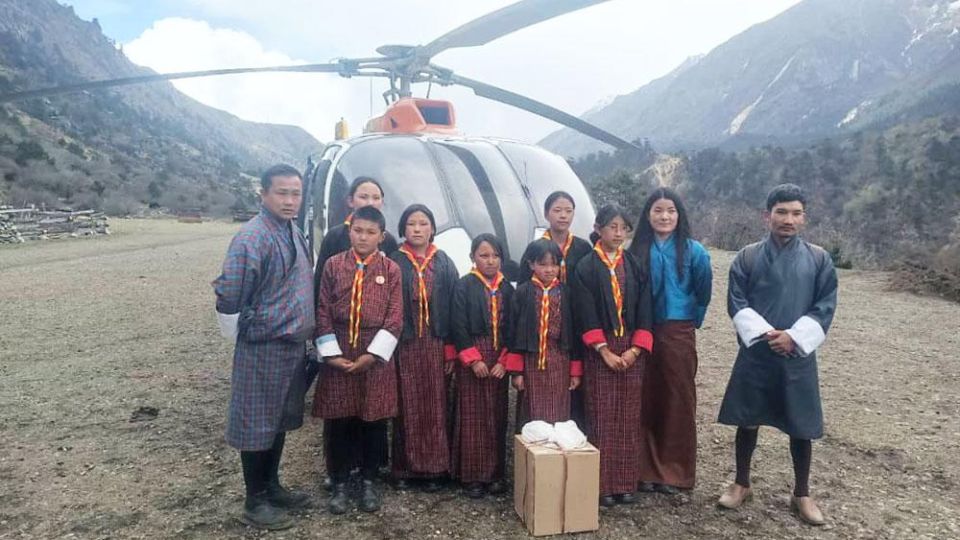April 21, 2025
THIMPHU – In the two most remote gewogs of the country, Lunana in Gasa and Lingzhi in Thimphu, both located 4,000 metres above sea level and without road access, the School Feeding Programme (SFP) is struggling to provide nutritious food.
It takes days to transport food on horses while helicopter transport is few and far between, and schools often rely on guests and travelers to bring in supplies.
No green leafy vegetables grow there. The little that does grow comes from greenhouses, which only start producing from late July to September. During the other months, students have modest meals, typically consisting of fried rice and chili flakes and ezay for breakfast with tea, and alternating between chickpeas, potatoes, or radish curry for lunch and dinner.
Despite these challenges, students in these areas receive the same stipend as other students across the country.
While schools try to serve egg and meat once a week despite their limited budget, it is expensive. In Lunana, a single egg can cost up to Nu 60, while in Lingzhi, the price ranges from Nu 600 to Nu 700 per tray. A kilogramme of chicken can cost up to Nu 1,000 in Lunana which are sold by local vendors.
All three schools in Lunana are part of the SFP. Lunana Primary School (LPS) has 34 students, all of whom are boarders. Each student receives a stipend of Nu 900 per month through SFP. This translates to roughly Nu 10 per meal, assuming the students receive three meals a day over 30 days.
Namgay Dorji, principal of LPS, said that the school faces the most challenges during spring and early summer, when the greenhouses are not producing. This is also a time when children do not have access to fresh vegetables at home either.
“Once the greenhouses start producing, students get access to green vegetables, which improves their nutrition. But during the difficult months, schools should be able to support them, because even if families have money, the remoteness means they still cannot get fresh vegetables,” he said. “At home, students might have instant noodles but not fresh produce.”
Namgay Dorji said that schools in Lunana were always on the lookout for who was coming up by helicopter. “We request guests, visitors, and officials on tour to help bring food supplies for the school. It is impossible to charter a helicopter for fresh produce for the school with the stipend.”
Mendrelthang Extended Classroom (MEC), a school in Lunana, has 11 students. Extended classroom students receive Nu 605 per month for SFP. The school provides breakfast and lunch.
Tshering Dorji, a teacher at the school, said that teachers tried to bring dried vegetables during holidays, but the helicopter’s weight limit makes bulk transport nearly impossible. “Since the school has few students, we are able to provide eggs or meat, be it chicken or yak meat, once a week,” he said.
In MEC, the school green house is only able to supply vegetables in October which is just one academic month in the entire year that students get to eat vegetables.
An official from the Gasa dzongkhag administration said that they were aware of the challenges schools in the highlands face in providing nutritious food to students.
“We had been pushing the education ministry for years to increase the stipend for students in these areas, given the unique challenges and high costs involved,” said the official. “Wherever possible, we are constantly trying to send supplies up there, looking for charter flights to Lunana that can carry them free of charge.”
Earlier this week, LPS and MEC received one box of eggs each, 210 eggs per school, through the One-Child, One-Egg initiative, launched this year to combat childhood malnutrition by providing one egg per student per day. For highland communities, even a single delivery is a breakthrough.
Bhutan Livestock Development Corporation Limited (BLDCL), the aggregator for the programme has signed an agreement with Druk Air to transport the eggs free of charge during its charter flight to Lunana. BLDCL is also exploring other possible options to transport eggs to Lunana.
LPS Principal Namgay Dorji said that both the school management and the students were deeply grateful to receive the eggs, as they would add the much-needed variety to the SFP, which usually had a limited supply.
“Even a single egg means the world to us because of how expensive, rare, and special it is in the highlands,” he said. “There may be criticism about just a box or two boxes of eggs being dropped off here, but for us, even one egg is special, because our children are the ones receiving it.”
The Lingzhi Lower Secondary School (LLSS) was initially included in the One-Child, One-Egg initiative. However, the revised list now includes only primary schools (290), special education institutes (five), and extended classrooms (50), leaving LLSS excluded.
Lingzhi Gup Wangdi said that the students of Lingzhi face similar challenges as those in Lunana due to the remoteness of both regions and similar climatic conditions.
“Our students eat the same meals every day—fried rice with chili for breakfast, and potato or radish curry for lunch,” he said. “Given the nutritional challenges we face here, unlike lower secondary schools in the lowlands, Lingzhi LSS should have been included in the egg programme.”
The school relies on porter services to transport rations and supplies, a journey that takes six days and costs Nu 700 per day.


